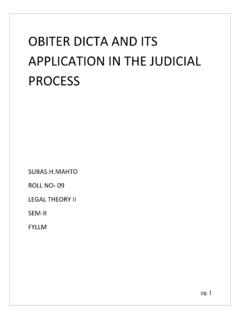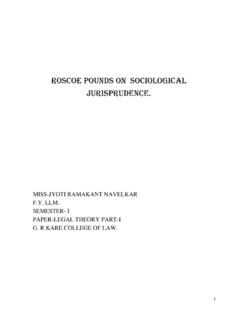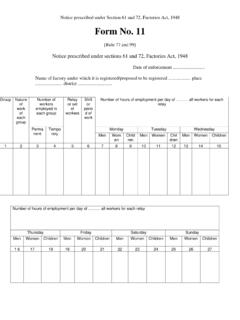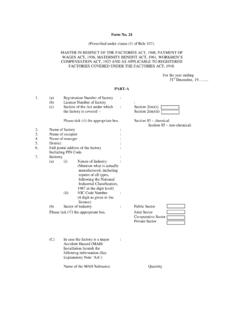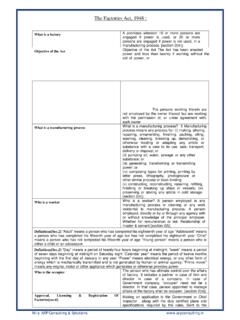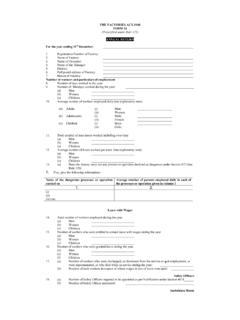Transcription of UNDER THE - Yola
1 LABOUR LAW Paper III HEATH PROVISIONS UNDER THE factories ACT, 1948 OCCUPATIONAL DEASEASES AND INDUSTRIAL INJURIES UNDER THE EMPLOYERS COMPENSATION ACT, 1923 Name: Samatina A. Fernandes G. R Kare College of Law. INDEX Sr. No. Title Page I Introduction 1-2 ILO conventions 3 II Definitions 4 III Purpose/Aims/ Objectives 5 IV Health Provisions UNDER the factories Act, 1948 6-11 V Chemical Hazards 12 Provisions relating to hazardous processes 13-15 Protection from chemical hazards 15 VI Occupational Health/ Diseases and industrial injuries UNDER the Employers Compensation Act, 1923:- 16-19 Schedule III - List of Occupational Diseases 17 VII Conclusion 20 Management to take steps 20 I.
2 INTRODUCTION: Occupational health deals with all aspects of health and safety in the workplace and has a strong focus on primary prevention of hazards. The health of the workers has several determinants, including risk factors at the workplace leading to accidents, musculoskeletal diseases, cancers, respiratory diseases, hearing loss, circulatory diseases, stress related disorders and communicable diseases and others. Employment and working conditions in the formal or informal economy embrace other important determinants, including, working hours, salary, workplace policies concerning maternity leave, health promotion and protection provisions, etc.
3 The research and regulation of occupational health and safety are a relatively recent phenomenon; as labor movements arose in response to worker concerns in the wake of the industrial revolution, worker's health entered consideration as a labor-related issue. In 1833, HM Factory Inspectorate was formed in the United Kingdom with a remit to inspect factories and ensure the prevention of injury to child textile workers. In 1840 a Royal Commission published its findings on the state of conditions for the workers of the mining industry that documented the appallingly dangerous environment that they had to work in and the high frequency of accidents.
4 The commission sparked public outrage which resulted in the Mines Act of 1842. The act set up an inspectorate for mines and collieries which resulted in many prosecutions and safety improvements, and by 1850, inspectors were able to enter and inspect premises at their discretion. Otto von Bismarck inaugurated the first social insurance legislation in 1883 and the first worker's compensation law in 1884 the first of their kind in the Western world. Similar acts followed in other countries.
5 The Constitution of WHO stipulates the fundamental right of all people to the highest attainable standard of health. In addition, article 2 of Chapter II - of the Constitution specifies prevention of accidental injuries and the pro- motion of improvement of working conditions as functions of WHO. WHO has had a special programme for occupational health since 1950 and close coordination and collaboration has taken place with ILO. The Alma Ata Declaration emphasized the need to organize primary health care services (both preventive and curative) "as close as possible to where people live and work".
6 The Declaration emphasized that in the organization of such services, high priority should be given to the people most in need, including the working populations at high risk. In 1979 a new strategy for the further development of occupational health was launched when the World Health Assembly adopted Resolution on the Comprehensive Workers Health Programme. In 1980, Resolution encouraged countries to integrate occupational health and primary health care services to cover underserved populations, particularly in developing countries.
7 In the same resolution a need for further development of occupational health services, training and research was emphasized. Health and Safety occupy a significant place in India's Constitution, which prohibits employment of children UNDER the age of 14 in factories , mines and hazardous occupations. This policy aims to protect the health and strength of all workers by discouraging employment in occupations unsuitable to the worker's age and strength. It is the policy of the State to make provisions to secure just and humane conditions at work.
8 The Constitution provides a broad framework UNDER which policies and programmes for occupational health and safety can be established. Legislation on occupational health and safety has existed in India for over 50 years. The principal health and safety laws are based on the British factories Act. The factories Act, 1948 has been amended from time to time, especially after the Bhopal gas disaster, which could have been prevented. The amendment demanded a shift away from dealing with disaster (or disease) to prevention of its occurrence.
9 The factories (Amendment) Act came into force on December 1, 1987. A special chapter on occupational health and safety to safeguard workers employed in hazardous industries was added. In this chapter, pre-employment and periodic medical examinations and monitoring of the work environment are mandatory for industries defined as hazardous UNDER the Act. A maximum permissible limit has been laid down for a number of chemicals. ILO conventions: The International Labour Organisation frames key conventions for protecting the rights of workers; many of them are specifically on occupational health and safety.
10 These conventions, once ratified by member states, form the guiding principles, for the formulation of national policies and laws. The ILO has 18 conventions that are targeted at addressing the issue of occupational safety and health (OSH). Though India has ratified 41 ILO conventions and treaties on labour welfare and labour rights to date, out of the 13 conventions on OSH, it has ratified only four conventions1. Convention No. 115- Radiation Protection Convention, 1960 Convention No.
